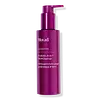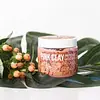What's inside
What's inside
 Key Ingredients
Key Ingredients

 Benefits
Benefits

 Concerns
Concerns

 Ingredients Side-by-side
Ingredients Side-by-side

Water
Skin ConditioningGlycerin
HumectantDecyl Glucoside
CleansingC13-16 Isoparaffin
SolventHexylene Glycol
EmulsifyingPropanediol
SolventHydroxyethyl Acrylate/Sodium Acryloyldimethyl Taurate Copolymer
Emulsion StabilisingLactobacillus
Skin ConditioningAlpha-Glucan Oligosaccharide
CleansingPolymnia Sonchifolia Root Juice
Skin ConditioningXylitol
HumectantXylitylglucoside
HumectantAnhydroxylitol
HumectantSodium Hyaluronate
HumectantSodium Surfactin
CleansingSqualane
EmollientUrea
BufferingYeast Amino Acids
HumectantTrehalose
HumectantInositol
HumectantTaurine
BufferingBetaine
HumectantIsohexadecane
EmollientCaprylhydroxamic Acid
Maltodextrin
Absorbent1,2-Hexanediol
Skin ConditioningPolysorbate 80
EmulsifyingAcrylamide/Sodium Acryloyldimethyltaurate Copolymer
Emulsion StabilisingCitric Acid
BufferingDisodium EDTA
Water, Glycerin, Decyl Glucoside, C13-16 Isoparaffin, Hexylene Glycol, Propanediol, Hydroxyethyl Acrylate/Sodium Acryloyldimethyl Taurate Copolymer, Lactobacillus, Alpha-Glucan Oligosaccharide, Polymnia Sonchifolia Root Juice, Xylitol, Xylitylglucoside, Anhydroxylitol, Sodium Hyaluronate, Sodium Surfactin, Squalane, Urea, Yeast Amino Acids, Trehalose, Inositol, Taurine, Betaine, Isohexadecane, Caprylhydroxamic Acid, Maltodextrin, 1,2-Hexanediol, Polysorbate 80, Acrylamide/Sodium Acryloyldimethyltaurate Copolymer, Citric Acid, Disodium EDTA
Water
Skin ConditioningKaolin
AbrasiveMontmorillonite
AbsorbentGlycerin
HumectantEthylhexyl Palmitate
EmollientCetearyl Alcohol
EmollientGlyceryl Stearate
EmollientPEG-100 Stearate
Beeswax
Emulsion StabilisingCeteareth-25
CleansingCeteareth-6
EmulsifyingStearic Acid
CleansingButyrospermum Parkii Butter
Skin ConditioningPhenoxyethanol
PreservativeParfum
MaskingCaprylyl Glycol
EmollientTocopheryl Acetate
AntioxidantHydroxyacetophenone
AntioxidantXanthan Gum
EmulsifyingIngredients Explained
These ingredients are found in both products.
Ingredients higher up in an ingredient list are typically present in a larger amount.
Glycerin is already naturally found in your skin. It helps moisturize and protect your skin.
A study from 2016 found glycerin to be more effective as a humectant than AHAs and hyaluronic acid.
As a humectant, it helps the skin stay hydrated by pulling moisture to your skin. The low molecular weight of glycerin allows it to pull moisture into the deeper layers of your skin.
Hydrated skin improves your skin barrier; Your skin barrier helps protect against irritants and bacteria.
Glycerin has also been found to have antimicrobial and antiviral properties. Due to these properties, glycerin is often used in wound and burn treatments.
In cosmetics, glycerin is usually derived from plants such as soybean or palm. However, it can also be sourced from animals, such as tallow or animal fat.
This ingredient is organic, colorless, odorless, and non-toxic.
Glycerin is the name for this ingredient in American English. British English uses Glycerol/Glycerine.
Learn more about GlycerinWater. It's the most common cosmetic ingredient of all. You'll usually see it at the top of ingredient lists, meaning that it makes up the largest part of the product.
So why is it so popular? Water most often acts as a solvent - this means that it helps dissolve other ingredients into the formulation.
You'll also recognize water as that liquid we all need to stay alive. If you see this, drink a glass of water. Stay hydrated!
Learn more about Water